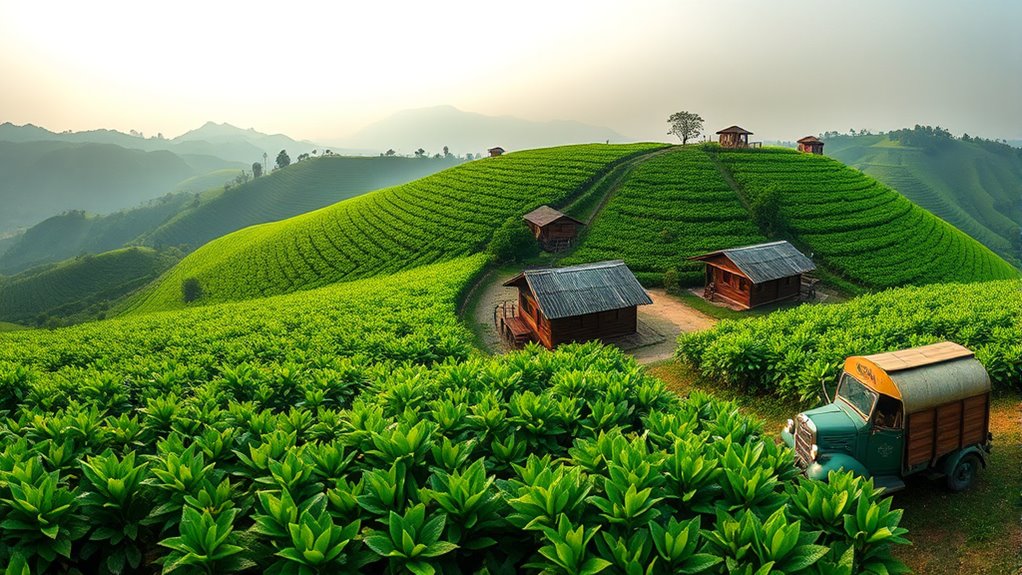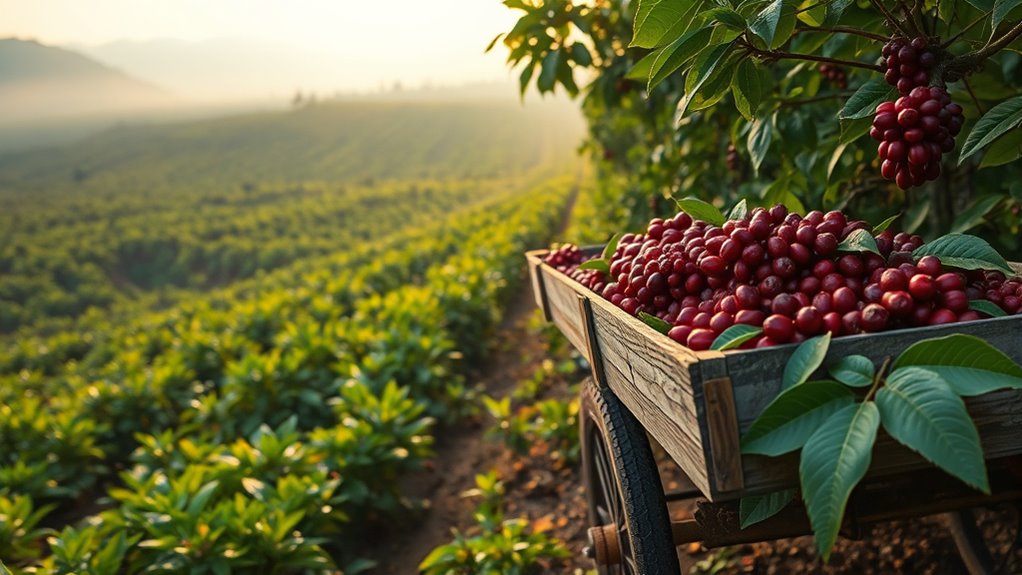Vietnam’s coffee boom has turned it into a global leader, especially in robusta production. The government plays a key role by providing subsidies and support, encouraging sustainable farming practices that protect the environment and improve bean quality. These efforts meet rising international demand for ethically sourced coffee. If you keep exploring, you’ll discover how Vietnam’s focus on sustainability and innovation secures its position as a future industry powerhouse.
Key Takeaways
- Vietnam transformed into a leading global coffee producer, focusing on sustainable, eco-friendly farming practices.
- The country dominates the robusta segment due to favorable climate and strategic plantation expansion.
- Government policies and subsidies support farmers in adopting sustainable methods, boosting productivity and quality.
- Rising global demand for ethically sourced coffee enhances Vietnam’s export growth and international reputation.
- Strategic investments and sustainability initiatives secure Vietnam’s future as a robusta industry leader.

Vietnam has transformed into one of the world’s leading coffee producers, with its vibrant industry fueling rapid economic growth and global recognition. As a coffee enthusiast or industry observer, you’ll notice how Vietnam’s rise has reshaped the global coffee market, especially with its focus on sustainable farming practices. This emphasis on sustainability isn’t just about protecting the environment; it also guarantees long-term profitability for farmers and stability for the industry. By adopting eco-friendly methods, Vietnamese farmers reduce their reliance on harmful chemicals and minimize deforestation, aligning their practices with international standards and consumer preferences. This approach helps maintain soil health, preserves biodiversity, and boosts crop resilience, all while supporting the country’s goal to be a responsible player in the global coffee market.
Your awareness of Vietnam’s shift towards sustainable farming highlights a strategic move to meet the rising demand for ethically sourced coffee worldwide. Consumers are increasingly seeking transparency and sustainability, and Vietnam’s commitment to these principles positions it favorably in the global market. This shift also benefits local farmers, who are now adopting more efficient and eco-conscious techniques that can lead to higher yields and better quality beans. As a result, the country’s coffee exports continue to grow, making Vietnam a dominant force in the robusta segment. This robusta power is driven by the country’s favorable climate, extensive plantations, and government support, which together create an ideal environment for large-scale production.
You’ll also see how Vietnam’s government has played a critical role in this transformation. Subsidies and technical assistance have helped farmers transition to sustainable farming practices and improve productivity. These policies encourage innovation, reduce costs, and secure the overall competitiveness of Vietnamese coffee on the global stage. The country’s focus on quality and sustainability has allowed it to carve out a unique position in the global coffee market, which is increasingly valuing ethically produced and environmentally friendly products. As Vietnam continues to expand its production capacity, it’s clear that its reputation as a robusta powerhouse will only strengthen, solidifying its influence in the international coffee economy. Overall, Vietnam’s commitment to sustainable farming practices and strategic investments has turned it into a key player, shaping the future of the global coffee market and guaranteeing its vibrant industry remains sustainable for generations to come.
Frequently Asked Questions
How Does Vietnam’s Climate Affect Coffee Quality?
Your coffee quality heavily depends on Vietnam’s climate impact, as ideal conditions like stable temperatures, ample rainfall, and altitude influence bean development. These quality factors guarantee the beans develop rich flavors and aromatic profiles. When the climate is favorable, it prevents pests and diseases, leading to healthier plants and better harvests. Conversely, unpredictable weather can hinder growth, reduce quality, and affect the overall flavor profile of the coffee you enjoy.
What Are Vietnam’s Main Coffee Export Markets?
You might be surprised, but Vietnam’s main coffee export markets are the United States, Germany, and Japan, dominating the global coffee trade like giants. These countries keenly import Vietnamese coffee, turning it into their morning magic. You can’t ignore how Vietnam’s coffee export destinations shape the world’s caffeine cravings. Whether it’s for a quick espresso or a smooth filter brew, Vietnam’s coffee travels far and wide, fueling millions of mornings worldwide.
How Does Coffee Production Impact Local Vietnamese Communities?
You see how coffee production impacts local Vietnamese communities by providing income for coffee farmers and supporting community development. As farmers cultivate and harvest coffee, they earn wages that boost local economies, enabling investments in infrastructure, education, and healthcare. This process creates jobs and fosters social growth, helping communities thrive. Your involvement in supporting sustainable coffee practices can further enhance these positive effects, ensuring long-term benefits for local communities.
What Sustainable Practices Are Used in Vietnam’s Coffee Industry?
You can support Vietnam’s coffee industry by promoting sustainable practices like organic farming and water conservation. Farmers are increasingly adopting organic methods to reduce chemical use, which benefits the environment and improves coffee quality. Water conservation techniques, such as drip irrigation, help preserve essential resources and ensure long-term productivity. By choosing coffee produced with these practices, you contribute to a healthier ecosystem and more resilient local communities.
How Has Coffee Consumption in Vietnam Changed Over Recent Years?
You’ve likely noticed that coffee consumption trends in Vietnam have shifted recently, with more people embracing specialty brews and premium options. Changing consumer preferences drive this growth, as younger generations seek new flavors and higher quality. You might also see increased demand for iced coffee and convenient options, reflecting a more modern coffee culture. Overall, these trends show a vibrant, evolving market that adapts to the tastes and habits of Vietnamese consumers.
Conclusion
As you watch Vietnam’s coffee story unfold, it’s clear the nation’s passion for this crop runs deep. While challenges remain, the resilience and dedication of Vietnamese farmers brighten the horizon. With every bean harvested, they nurture more than just a crop—they cultivate hope. Though the journey isn’t without its twists, the future holds the promise of continued growth and opportunity, reminding us that even in change, there’s a gentle beauty waiting to bloom.








